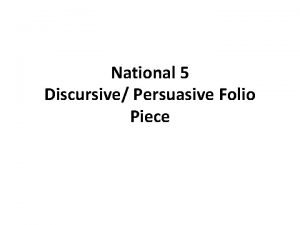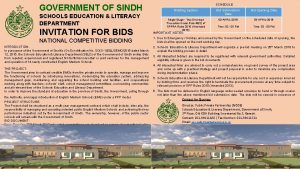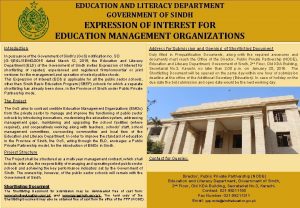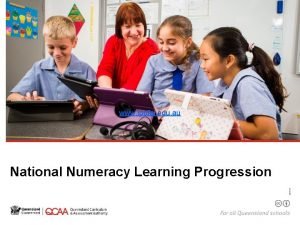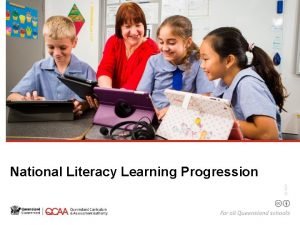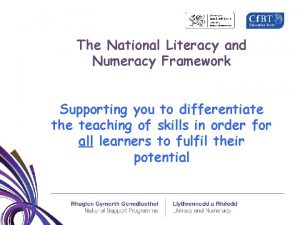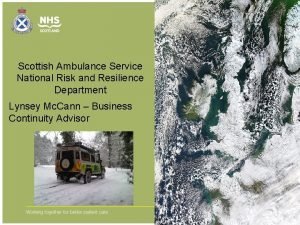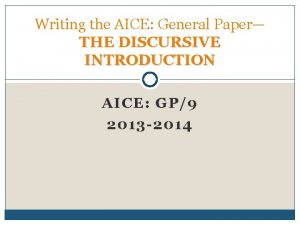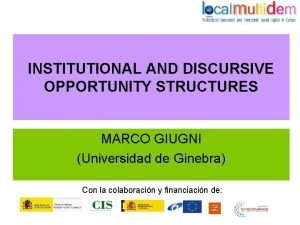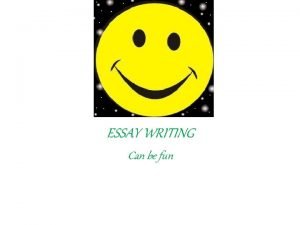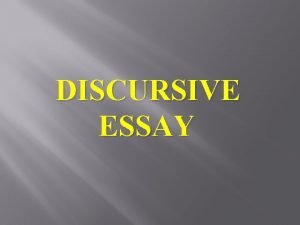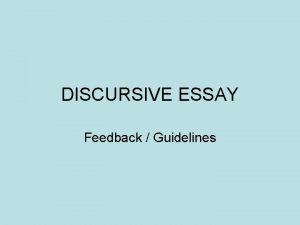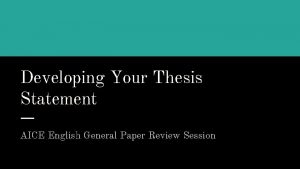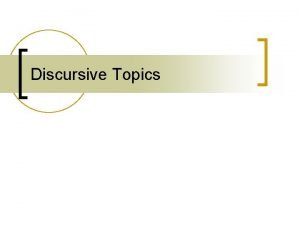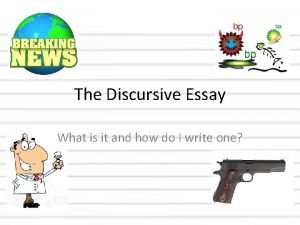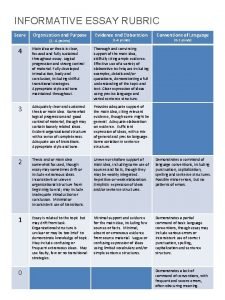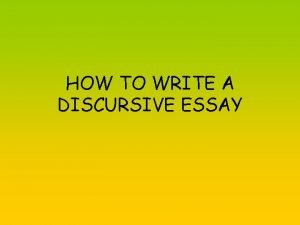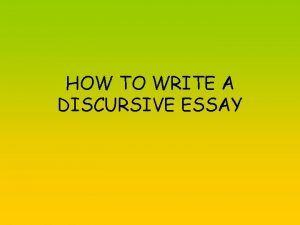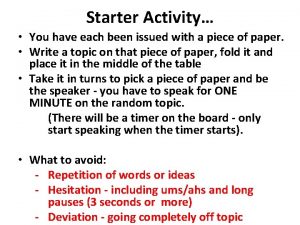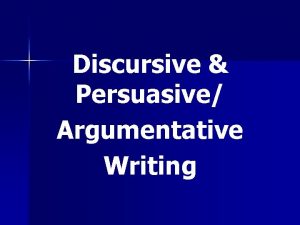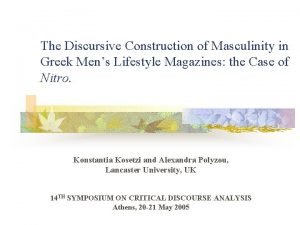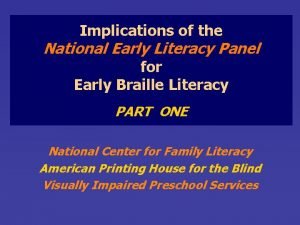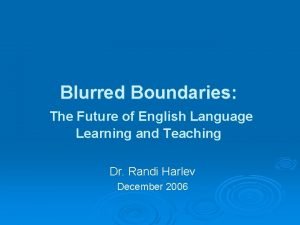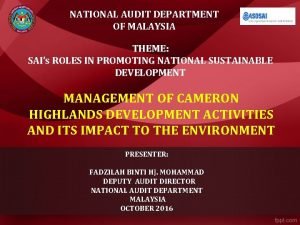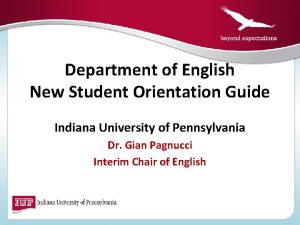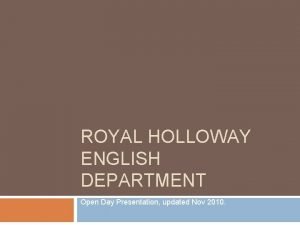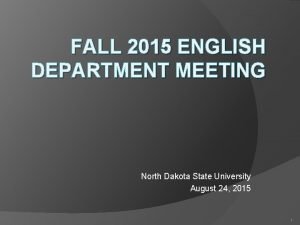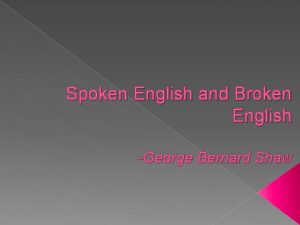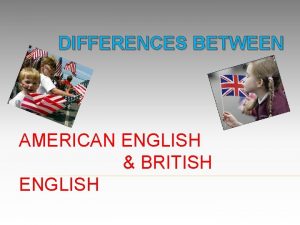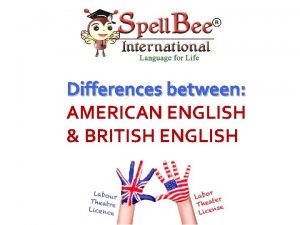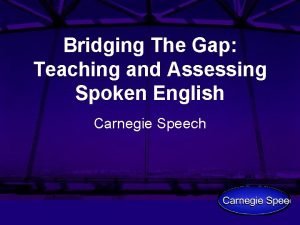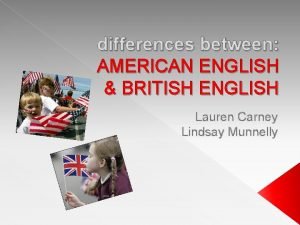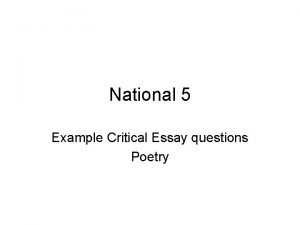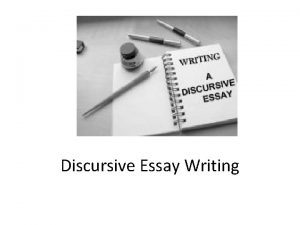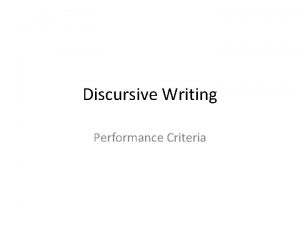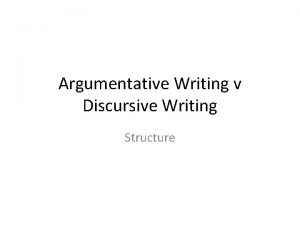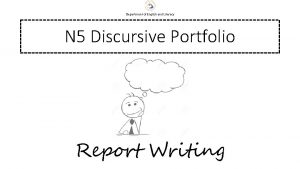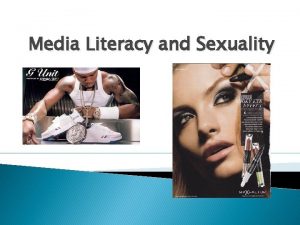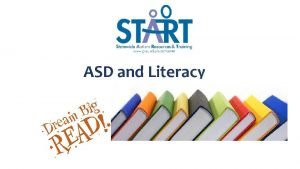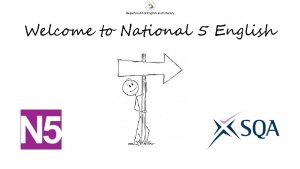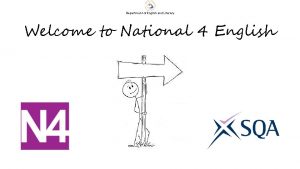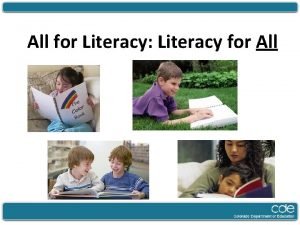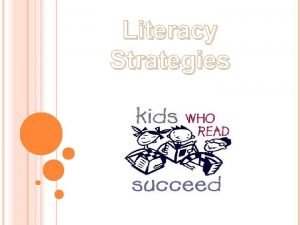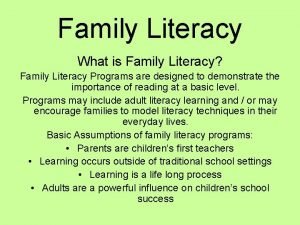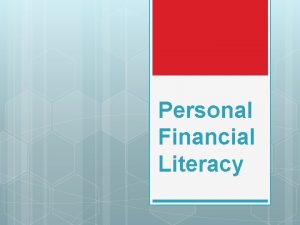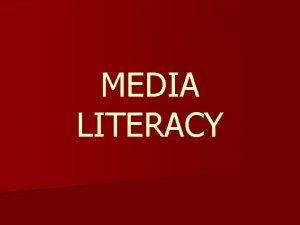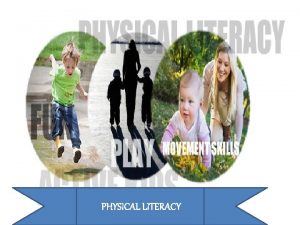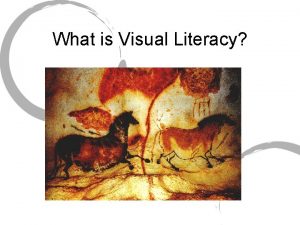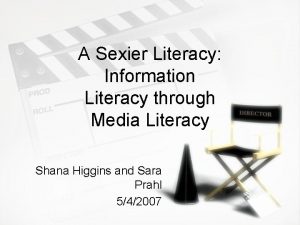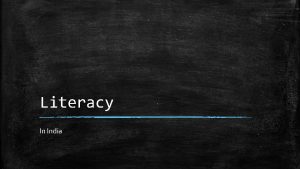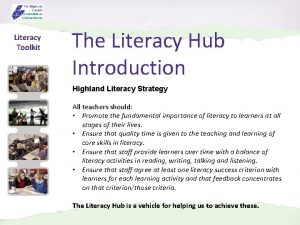Department of English and Literacy National 4 Discursive












































- Slides: 44

Department of English and Literacy National 4 Discursive Writing: Biography

The Learning • Remembering, understanding and applying the discursive writing skills you already have • Understanding, analysing and evaluating examples of other people’s discursive writing • Creating an original piece of discursive writing Numeracy Literacy Working with Others Employability Cultural Literacy Critical Thinking Digital Literacy Health & Wellbeing Wider Achievement Political Literacy

Learning Activities 1. Choosing a subject and planning your ideas 2. Writing a rough draft 3. Editing and revising your rough draft 4. Creating your final submission and reviewing your learning Significant Aspects of English and Literacy

1. Choosing a subject and planning your ideas Success Criteria üRead ‘What is a biography? ’ and watch the clips provided üRead the ‘Choosing a Subject’ slides and decide on your subject üTake a note of the ‘Possible Headings and Research/Interview Questions’ and make your own – depending on your subject üRead the various models to give you ideas on layout, content and language

What is a Biography? A biography is writing about someone’s life. It is usually written both to inform and to entertain. This means it is a mix of factual information and creative writing. The audience is usually made up of people who are interested in the person being written about. However, sometimes biographies of people who aren’t well known can be interesting because of an experience that they’ve had. Watch this clip which tells you more about what a biography actually is: https: //www. youtube. com/watch? v=i 4 z. XB_RM-8 M Watch this clip on how to write a successful biography: https: //www. youtube. com/watch? v=q 7 ablu. Gwup 8

Choosing a Subject: Option 1 The obvious choice is often a famous person who is well known. There may be lots of information about them online and there might even be existing biographies out there about them. The problem with picking someone like this is that it can be unoriginal and difficult to decide what information to use as there is so much.

Choosing a Subject: Option 2 Another option is to write about someone you actually know. It could be someone in your family; a family friend; or maybe someone that you know through a hobby or interest. The main issue is that you are able to get detailed information about them. How do you do that? • Interview face to face (if possible) • Phone or video call them (if appropriate) • Send them a list of questions via email or text (if appropriate) • Ask a third party (like your parents) about them

Choosing a Subject: Making a Decision 1. Make a list of possible subjects 2. Jot down a brief list of things you already know about these people 3. Add to this list any other ways that you could get information on them 4. Decide on the person you think you will be able to write about most successfully

Possible Headings and Interview/Research Questions Possible Heading: Early Life • Name • Details of birth: including where and when • Parents • Brothers and sisters: names, information about them • Home/Neighbourhood • • Possible Heading: Education Primary: Where? When? Memorable Teachers/Friends Memorable experiences (good and/or bad) experiences Secondary: As above Subjects preferred and why College/University: As above Course taken Memorable experiences

Possible Headings and Interview/Research Questions Possible Heading: Childhood • What games did you like playing when you were a child? • Describe your favourite toy? • What were your favourite pastimes? • Who were your childhood heroes and why? • Where did you go on holiday when you were young? • What were your favourite sweets? • Describe your happiest childhood memory? • • • Possible Heading: Growing Up Describe your pastimes when you were a teenager. What was your favourite music when you were a teenager? What was your favourite item of clothing when you were a teenager? What was the first film you ever saw in a cinema? What did you want to be when you left school?

Possible Headings and Interview/Research Questions Possible Heading: Employment • Give details about your first job after leaving school: Where was it? What did it involve? How much did you get paid at first? Did you enjoy it? • What other jobs have you had? Where/When/ What did you do in each? • What do you like /dislike about your current job? (or being retired? ) • How long have you been in current job? • Do you think you will stay in that job? Possible Heading: Achievements/Hopes/Regrets • What are you most proud of (Children? Award? etc. ) • What are your hobbies? • How do you like to spend your free time? • Do you have children? (Names? When born? ) • Do you have any regrets? Why?

Possible Headings and Interview/Research Questions Possible Heading: Final Thoughts • What do you think has changed most since you were young? • What are your main hopes or ambitions for the future? Own Headings and Question Ideas:

Early Life Model 1 Frances Berwick, nee Curran, was born on the 30 th October 1956 at the Rottenrow Maternity Hospital in Glasgow. Her mother Margaret was a supervisor in a factory and her father John was a security guard. She was the youngest of four children, with two older sisters Neve and Violet and an older brother called John. The family home was in Murrayfauld Drive in Parkhead, Glasgow, and Frances was very happy there.

Early Life Model 2 Born at number fifty-two Belmont Street in a single end flat in Parkhead, Charles Smith arrived on the 11 th February 1938. Charles was the fourth of seven children born to Patrick and Amy Smith. He was the first son, but was to be followed by two more brothers, Patrick and Dominic were born and saved him from years of torment and torture by his older sisters. In his early years Charles was evacuated to Langhome during the Second World War, where he would usually spend his days bored and uncomfortable being in a strange place with a strange family. To pass the time when they were not playing football or hide and seek, Charles and his friends would make themselves toy swords and guns from spare wood and nails. In his first years there were never really any toys and definitely no games consoles so when it came to Christmas Charles would usually get an orange and a tanner (sixpence). One of his Christmas presents that vividly remembers getting were a pair of giant gloves which he claims still would be too big today.

Early Life Model 3 Johann Mary Jones was born on the 20 th of October 1968, at Belvidere hospital in Glasgow. Johann was brought up by her parents Margaret and James Melly, and her earliest memory is playing in the stream and fields near her home with her brothers and sisters. They would always run around catching frogs, wasps and bees in jam jars. Johann spent her first eleven years at 12 Alnach Place and has very fond memories of her time there. Being part of a very large family, she had to share her bedroom with her three sisters so she had little of her own space. She would escape by playing with her doll’s house, made for her by her favourite uncle. The doll’s house was large with big wooden windows and had 12 rooms in total. Johann’s favourite room was the children’s bedroom because it looked like her real bedroom and she would imagine living in such a big house.

Early Life Model 4 Caroline Mc. Shane arrived into the world on February 16 th, 1971 at Rottenrow hospital in Glasgow. She was the youngest of seven with five older brothers named Jim, William, Alex, Stuart and Robert and her one sister Pauline. Her mother Joan worked as a cleaner to ensure that her children had the best upbringing that she could give them. Her father Alexander also worked all of his days as a mechanic to earn as much as he could for the family.

Early Life Model 5 Joseph Statham was born on a bitterly cold evening in Glasgow on November 15 th, 1963, the youngest of four children. He has one brother, Paul and two sisters Rachel and Ann. His mother was a cleaner and his father worked in a factory. Joseph was a happy and healthy child and his earliest memory is riding his second-hand bike in his close in Easterhouse. He loved that bike and had it for years. When Joseph was a young child he also used to love to play hide and seek with his siblings. Being the youngest and small for his age had its advantages as he was able to hide in very small spaces and usually won the game.

Education Model 1 Catherine was very eager to start primary school, not least because her house was so crowded. She began school at St. Alphonsis primary school at the age of five. As a pupil she was very eager, pleasant and well-behaved. She always did what she was told. Of course, the authority and strict discipline of the teachers prevented any opportunity of ever doing something wrong. Her feelings about secondary school were very different. When she first started Weslin Street Secondary she was terrified. The navy blue pinafore probably did not help her insecurity as it was very unattractive and she was teased wearing it. However, as the years went on she began to like it more and made many new friends. Her favourite subjects were cookery, art and domestic science and her favourite teacher was Miss Murphy as she was such a pleasant and friendly person. Even though Catherine enjoyed school very much, she left at the age of fifteen and went straight into a job.

Education Model 2 Helen Kelly attended St Jude’s primary school. There she met her best friend Cathryn Mc. Clafferty. Helen and Cathryn were known to all the teachers but for all the wrong reasons. They were known as the terrible twosome. They were the school bullies, something Helen is very ashamed of now. Being hit with the belt several times for fighting did not stop them though as they enjoyed their hard reputations.

Education Model 3 Geoff’s school career got off to a bad start. During his first year, he was diagnosed with celiac: a genetic disease which causes sickness and diarrhoea. He was sent into hospital for three months to undergo treatment to try and stabilize the condition. A side effect of to the treatment was caused memory loss, which meant Geoff had to re-sit primary one. He was of course oblivious to the people he had met and the things he had learned the previous year so he did not actually realize that he was redoing it all over again. Geoff says that it turned out to actually be a good thing in the long run as it enabled him to hit adolescence before many of his classmates which made him a hit with the girls.

Education Model 4 Secondary school was just as enjoyable for Joseph and he particularly loved studying art in a well-equipped classroom. Time always seemed to race by when he was in Art, unlike in Home Economics which he hated. Everything he cooked burned and in exasperation the teacher eventually sent him out to get the shopping during the periods instead, much to the relief of both of them. Joseph left school in 1974 at the end of fourth year and went straight on to further education at Anniesland College where he studied painting and decorating. He learned a lot about painting and was very good at it. During this he had a parttime job working in an ice cream van. The work was not that well paid, he only received two pound a day. However, he loved working on the van as he enjoyed serving the customers and it also kept him out of trouble.

Education Model 5 Caroline's first years of education began at St Jude's Primary School in Barlanark. In her opinion her primary years were the best years of her school life. She would not have made it through primary without her best friend, Jean Mc. Intyre who was also her cousin. Caroline went through a bad couple of months in school as older girls were trying to bully her as she was quite quiet and shy, but with the help of Jean she managed to get through it. After seven long years, she moved on to attend St Andrew's RC Secondary school. Her only complaint about her time at secondary school was the fact that some of her lessons were taught in huts as a result of overcrowding. The huts were freezing cold in the winter and incredibly hot in the summer. Unfortunately, Caroline left school with no qualifications as she found it difficult to concentrate on her school life as her mother took a stroke when she was only fifteen years old. As a result of this, she was only interested in making sure her mother was well because all of her brothers had grown up and moved away.

Employment Model 1 Throughout his life Charles had a great many jobs in a variety of locations. He started out aged fifteen as an apprentice pipefitter. Once his apprenticeship was finished and he was a certified pipefitter Charles went and did his mandatory two years National Service in the army before taking up a full-time job as a pipefitter. He enjoyed National Service and was not particularly homesick which was good as it would stand him in good stead for his future. When he did start his job he worked as a foreman pipefitter welding and fabricating pipes on oil and gas rigs in the north of Scotland. Charles also left Scotland for three months in 1979 to go and work in Saudi Arabia. At the time, this was a very big adventure and many of his fellow workers would have refused to go, but Charles loved travelling and thrived in his new environment. The only difficulty he found was coping with the heat, which was often unbearable. After a short break when he returned home Charles was sent away again, this time to an oil rig just off the coast of Aberdeen for a year, working two weeks on two weeks off. He enjoyed the work immensely and loved the variety of moving around different places.

Employment Model 2 Theresa’s first job after she left school was working as machinist. She enjoyed working on machines and therefore stayed on the job for five and a half years. She left this job to have her family John born 10 th January 1958 and then her second, Peter born 10 th June 1961. She then had her third and final child Anna on 13 th March 1974. Two years later she started a job working in the Danish Food Centre at the age of around 39. Working there was difficult to start off for Theresa as she had to wash piles of dishes for hours and hours but she got into a routine where it came to the point that she finished quicker and found it easy. She made many friends but disliked having to chop sacks of onions. She had to stop occasionally because she was crying so much that she could not see any longer. Theresa worked in the Danish Food Centre for about seven and a half years.

Employment Model 3 Part of the reason John underachieved at school was because his passion lay elsewhere. From the age of fourteen, John dreamed of becoming a professional boxer. By the age of nineteen, after five years hard work, he was John the Scottish champion at cruiser weight. He credits his father for his success as it was his father who took him running every morning and after school, and took him to training six days a week. It is only now that he is a father himself that John truly understands how much his father sacrificed for him, especially his precious free time to help John train. John’s boxing glory came to an end when he gave it up for the love of a woman. When he met his future wife he realised that he would not be able to see her and keep up the level of training, so he reluctantly decided to retire. He did briefly resurrect his career at the age of twenty-five, stopping for good two years later because his heart was not in it anymore. In his career he had forty-six fights, with thirty-five wins and eleven defeats. He prides himself on the fact that he was never knocked out. A modest man, he does not display the thirty-seven trophies from his boxing career and rarely speaks of his success.

2. Writing your rough draft Success Criteria üGet something down on the page as quickly as you can - at this stage, it doesn’t have to be perfect üConcentrate on letting your work flow – try not to stop and start too many times üYou should attempt to write approximately 500 – 700 words üUse the success criteria for biography üMake sure you also follow the ‘Tools for Writing’ success criteria too üCheck out the ‘Starter Suggestions’ slides if you need help to get started

Biography Success Criteria ü An introduction that explains why you have chosen the person ü A clear topic sentence at the start of every paragraph that introduces the content of that paragraph ü Write in chronological order ü Include accurate facts with references (if appropriate) ü Use language techniques that will make your writing more enjoyable for the reader (see slide) ü A conclusion that sums up the important points about the person and a final point that shows the reader why this person is worth knowing about

Possible Language Techniques: • Narration - the voice that tells the story. For biography, use third person (he/him/she/her). This has the effect of interesting your reader in the story with a warm and inviting but authoritative voice. • Description - describing words such as adjectives, adverbs, similes and metaphors that add detail. It helps engage readers by creating vivid pictures and feelings in their 'mind’s eye'. • Dialogue - the direct speech of characters (real or made up), shown inside quotation marks. We all judge characters by what they talk about and by the way they speak. Dialogue a key technique for creating interest and realism. • Alliteration - repetition of the same beginning sounds in nearby words. This can create a useful emphasis, maybe to highlight a sound or movement, or to intensify feeling or even to bind words together. • Connotation - a word’s meaning can be literal, as in 'It looked like a cat', or it can create connotations as in 'As soon as the food reached the table, the boy pounced on it like a cat. ' A connotation is a meaning created by a special use of a word in a particular way or context. It works by adding some kind of emotion or a feeling to a word’s usual meaning. All literature depends upon using language that creates connotations. They engage the reader because they evoke reactions and feelings. • Personification - this is a technique of presenting objects as if they have feelings: 'the rain seemed to be dancing merrily on the excited tin roof. ' This creates a sense of emotion and mood for the reader. • Repetition - the action of repeating a word or idea. This can add emphasis or create an interesting pattern of sound or ideas. • Onomatopoeia - use of words which echo their meaning in sound, for example, 'whoosh' 'bang'. Using this can add emotion or feeling that helps give the reader a vivid sense of the effect being described. • Simile - a kind of description. A simile compares two things so that the thing described is understood more vividly: 'The water was as smooth as glass. ' (Hint - 'like' or 'as' are key words to spot as these create the simile). A simile can create a vivid image in the reader’s mind, helping to engage and absorb them. • Symbolism - we grow up learning lots of symbols and these can be used in stories to convey a lot of meaning as well as feeling in a single idea or word: a red rose can symbolise romantic love; a heavy buckled belt can hint at the power held by the character; an apple can even symbolise temptation if it is used in a way that the reader links to the apple that tempted Eve in the Garden of Eden.

Tools for Writing Success Criteria üSpell most of the words used correctly üUse punctuation that is varied and mostly accurate üUse sentences of different types and lengths üUse paragraphs correctly to structure writing üPresent work in a clear and legible way

Starter Suggestions: Early Life x was born on…. . X arrived early on…. . Born at 11 Acacia Avenue on the 25 th December 1976, x was….

Starter Suggestions: Education You may want to write a separate paragraph on primary school and secondary school if you have plenty to say. You could also have a separate paragraph on college/university. In ____ X started _______ Primary school. X loved school. X was nervous about starting secondary school. John’s school career was really successful… Laura had mixed feelings about school… Darren never really enjoyed school…

Starter Suggestions: Education/Employment X left school in_____ and got his first job working for______ When X left school she was unsure of what to do next… After university, X had many interviews before getting a job with… X had many jobs after school, struggling to find one she enjoyed.

Starter Suggestions: Growing Up When X was ____ he met____ who would later become his wife. In ____ X gave birth to a beautiful… X always wanted a family of her own….

Starter Suggestions: Achievements/Hopes/Regrets You might want to divide this into a number of different paragraphs depending on the information you have gathered. Throughout her life X had many hobbies, but today she enjoys… X has always lived a very active lifestyle… When he is not working or spending time with his family, X loves to… There are many things that X is proud of. X’s greatest achievement to date is… Despite living a very happy life, there are some things X would go back and change if she could. X has many hopes and plans for the future….

3. Editing and revising your rough draft Success Criteria ü Read the ‘Why Edit and Revise’ slide ü Read back over your finished piece – how does it sound out loud? ü Can you read it to anyone else and let them give you some feedback? ü Read it backwards, one sentence at a time – that way you will spot many more things you want to change ü Follow each of the steps on the ‘Checklist’ slides – use different colours of pen or highlighters if you have them to make each stage of correction clear ü Contact the teacher for advice if there’s anything you are not sure about

Why Edit and Revise? When you are ready to share your writing with others, it is important to take time to re-read what you have written to make sure that your message is clear and that your spelling, punctuation and grammar are polished. The word revision means to ‘look again’. After writing a rough draft, successful writers ‘look again’ at their writing to make sure that they have accomplished what they set out to do.

Stage 1 Checklist: Purpose, Audience and Form Purpose Is your piece designed to Inform? Persuade? Explain? Entertain? Maybe it’s a mix of them all? ü Make sure you know the purpose of what you are writing and that is clear for the reader too. Audience Who is your piece aimed at – who is your readership? Is it a specific age group? Maybe it’s people who have a particular job or interest? ü Make sure that everything you have written is geared towards engaging the group you are aiming at. Form What type of writing should your piece be? What layout and presentation should you have? For instance: if it’s a biography, do you know how to set that out properly? ü Make sure you have chosen the correct format for your writing.

Stage 2 Checklist: Vocabulary Creative Writing Have you used similes, metaphors, personification and other types of imagery? What about a variety of adjectives, verbs and adverbs? Discursive Writing Have you used straightforward and formal language for a report? Have you used subject specific words? What about persuasive vocabulary for a speech or an essay? üMake sure you have thought carefully about all of the words you have used as they will help the reader to understand relate to your piece.

Stage 3 Checklist: Tools for Writing Spelling Have you checked the spelling of the words you often get wrong? Have you checked the spelling of new words? üCorrect any spelling errors that you can see. Punctuation Have you used the correct punctuation? Does your piece contain a good range of punctuation? Have you left any punctuation out? üCorrect any punctuation errors that you can see. Grammar Does it make sense? Can you track back through the sentences that don’t make sense to see where you’ve gone wrong? üFind and change all of the errors you can.

Stage 4 Checklist: Organisation Presentation Does it look nice on the page? Is it spaced out well? Have you used a certain design or theme all of the way through? Have you used bullet points and/or graphics? üMake sure the way you have presented your work is in line with the way that is expected. Sections/Paragraphs Is it organised into clear paragraphs? Are there topic sentences and signposts to help guide the reader through your piece? Does it contain headings and subheadings if your piece requires them? üMake sure your finished piece is organised in a way that helps readers understand it.

Stage 5 Checklist: Editing Remove Do you have words or sentences that don’t seem to fit in? Have you changed your mind about a reference you’ve used? Have you got any words or sentences that were not bringing anything to your piece? üTake away 1 – 3 sentences from anywhere in the piece that you think were not as strong as you would have liked. Add Have you missed out any words? Maybe you’ve forgotten to add an important point or piece of description? üTry adding between 1 – 3 sentences that you think will make more of an impact in your writing.

Model Edit Purpose: to describe my ideal place √ Audience: teacher family √ Form: biography √ Before the process During the process Part of the reason John done badly at school was because he wasn’t interested. From the age of forteen, John wanted to be a professional boxer. By the age of nineteen, he was the Scottish champion at cruizer weight. He says his father for helped him be a success as it was his father that took him running every morning and after school and took him to training six days a week. at school was because he wasn’t interested his passion lay elsewhere. From the age of fourteen, John dreamed of becoming a professional boxer. By the age of nineteen, after five years hard work, he was the Scottish champion at cruiser weight. He says his credits his father for his success as it was Vocabulary: his father who took him running every morning some changes and after school, and took him to training six days a week. It is only now that he is a father himself that John truly understands how much his father sacrificed for him, especially his precious free time to help John train. Part of the reason John done badly underachieved Presentation: √ Paragraphs: √ Tools for writing: Editing: (Add/Take some corrections Away) some changes

4 a. Creating your final submission Success Criteria ü If working digitally: type with a plain black font, 12 point ü If handwriting: use lined A 4 paper and a blue or black pen ü Include all of the corrections/changes you have made ü Make a front cover with your name, class and title on it ü Send your final submission in by Wednesday 24 th June ü If photographing a handwritten piece, ensure it is a clear picture and all of the text can be read easily

4 b. Reviewing the Learning Success Criteria üAre you pleased with your biography – what do you particularly like about it? üIs there anything you found challenging about the task? üIf you did the task again, would you do anything differently?
 National 5 folio
National 5 folio Similarities of media information and technology literacy
Similarities of media information and technology literacy Mil curriculum guide
Mil curriculum guide Who are the people in media
Who are the people in media Cyber literacy for the digital age
Cyber literacy for the digital age Sindh education and literacy department
Sindh education and literacy department Sindh education and literacy department
Sindh education and literacy department National numeracy learning progression
National numeracy learning progression Literacy continuum acara
Literacy continuum acara National literacy framework
National literacy framework National risk and resilience unit
National risk and resilience unit Aice general paper essay example
Aice general paper essay example Discursive opportunity structure
Discursive opportunity structure Discursive writing examples
Discursive writing examples Discursive essay introduction
Discursive essay introduction What is a discursive essay
What is a discursive essay Discursive thesis statement
Discursive thesis statement Aice general paper essay format
Aice general paper essay format Discursive topics
Discursive topics Discursive composition
Discursive composition Informative essay rubrics
Informative essay rubrics How to write a discursive essay
How to write a discursive essay Discursive essay plan
Discursive essay plan Discourse and socially situated identities
Discourse and socially situated identities Discursive text
Discursive text Persuasive vs discursive
Persuasive vs discursive Marco giugni ferrari
Marco giugni ferrari National early literacy panel
National early literacy panel English literacy in europe
English literacy in europe National core standards south africa
National core standards south africa National audit department
National audit department National unification and the national state
National unification and the national state Iup english department
Iup english department Strategic planning institute
Strategic planning institute Royal holloway english department
Royal holloway english department Ndsu disability services
Ndsu disability services Spoken english and broken english
Spoken english and broken english British and american word differences
British and american word differences Difference between american and british english
Difference between american and british english Spoken english and broken english summary
Spoken english and broken english summary American english and british english
American english and british english Opportunities and challenges
Opportunities and challenges National 5 critical essay questions poetry
National 5 critical essay questions poetry How to link back to a question
How to link back to a question Mae hen wlad fy nhadau translation
Mae hen wlad fy nhadau translation
